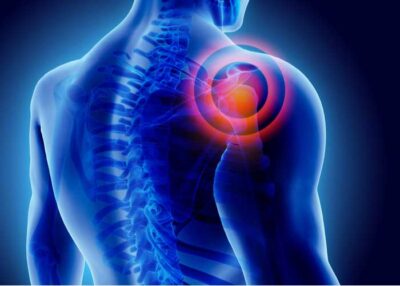Shoulder Instability Specialist

Do you play contact sports or have you been in an accident that caused a blunt-force trauma to your shoulder? If so, you may be at risk of having a shoulder dislocation or a shoulder separation. Shoulder dislocations can cause shoulder instability, pain and the feeling that the shoulder may slip out of joint. Shoulder instability Doctor Matthew Provencher provides diagnosis and both surgical and nonsurgical treatment options for patients in Vail, Aspen, Colorado Springs, and the Denver, Colorado area who are experiencing symptoms of shoulder instability. Contact Dr. Provencher’s team today!
What is shoulder instability?
The glenohumeral joint is one of four joints within the shoulder complex and is formed at the junction of the head of the humerus (upper arm bone) and the glenoid portion of the scapula (shoulder blade). This shoulder joint is arranged as a ball-and-socket that enables joint movement in multiple directions; however, the large range of motion makes the shoulder inherently susceptible to shoulder dislocations and other shoulder instability issues. If the soft tissue restraints within the shoulder become damaged from trauma, a shoulder separation can occur. When joint separation occurs, the tendons and ligaments are torn or stretched from their attachment site. The resulting damage to these soft tissues inhibits their ability to provide stability and strength to the shoulder. Shoulder instability is the condition of weakened soft tissues within the shoulder that can cause recurrent shoulder dislocations. Athletes, particularly those that perform repetitive overhead movements such as those seen in baseball, swimming, and volleyball, are at a greater risk of developing shoulder instability. Dr. Matthew T. Provencher, orthopedic shoulder specialist serving patients in Vail, Aspen, Colorado Springs, and the Denver, Colorado area, has the knowledge and understanding, as well as substantial experience in treating patients who have experienced shoulder instability.
What are the symptoms of shoulder instability?
A common complaint of shoulder instability is shoulder pain following an injury. This pain often worsens with activities such as reaching behind the back or throwing a ball. Other common symptoms of shoulder instability include:
- Decreased range of motion of the affected shoulder or arm
- Swelling and/or bruising
- A sensation of the shoulder joint giving out
- Recurrent shoulder dislocations

How is shoulder instability diagnosed?
A comprehensive medical history will be obtained, including the initial injury and any history of recurrent shoulder dislocations. Dr. Provencher will perform a thorough physical examination to evaluate for chronic shoulder instability. Diagnostic imaging may be recommended depending on the injury severity. X-rays can show any damage to the bones of the shoulder joint. Magnetic resonance imaging (MRI) can confirm a shoulder instability diagnosis and establish the specific soft-tissue structures that sustained damage. Additional imaging, such as an arthrogram, may also be requested to rule out damage to any other structures within the shoulder joint.
What is the treatment for shoulder instability?
If a shoulder dislocation is suspected, immediate medical attention by a medical professional or orthopedic shoulder specialist is strongly advised.
Non-surgical treatment:
If a shoulder dislocation diagnosis is confirmed, manual manipulation of the humeral head back into the glenoid socket is essential. This joint reduction technique should only be performed by a medical professional who is experienced in this procedure. If the shoulder joint is successfully reduced, pain should immediately improve.
Following a successful reduction of the shoulder joint, Dr. Provencher will immobilize the shoulder joint with a sling, or other immobilization device, for the ligaments to properly heal. Dr. Provencher will recommend range-of-motion exercises and will offer education regarding safe positions for the shoulder after injury. A combination of rest, ice, and non-steroidal anti-inflammatory medications (NSAIDs) can be used for pain and inflammation management. If the pain is not alleviated with oral medications, a corticosteroid injection may be recommended, depending on the injury. When appropriate, a physical rehabilitation program will be implemented to strengthen the shoulder.
Surgical treatment:
In the event of an unsuccessful shoulder joint reduction, or severe shoulder instability, Dr. Provencher may encourage treatment with a shoulder arthroscopy. A small camera (arthroscope) and specialized surgical instruments are used in this minimally invasive procedure to examine and repair the damaged soft tissues of the shoulder. This arthroscopic surgical procedure is effective at correcting shoulder instability while also decreasing the recovery time for patients to return to their normal daily activities.
For more information on shoulder instability, or the excellent treatment options available, please contact the office of Dr. Matthew T. Provencher, MD, orthopedic shoulder specialist at The Steadman Clinic, serving Vail, Aspen, Colorado Springs, and the Denver, Colorado area.